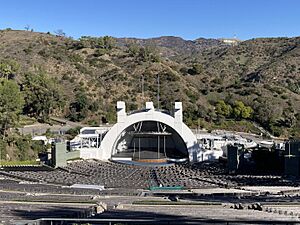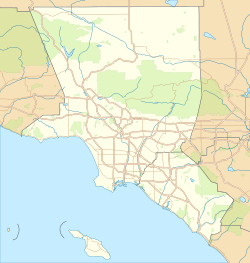Hollywood Bowl facts for kids
 |
|

The Hollywood Bowl in 2024 with the Hollywood Sign in background
|
|
| Location | 2301 North Highland Avenue Los Angeles, California |
|---|---|
| Coordinates | 34°06′46″N 118°20′20″W / 34.11278°N 118.33889°W |
| Public transit | at Hollywood/Highland Line 224 (both directions) Line 222 (southbound only) |
| Owner | County of Los Angeles |
| Operator | County of Los Angeles Los Angeles Philharmonic Association |
| Type | Outdoor Amphitheater |
| Seating type | reserved seating |
| Capacity | 17,500 |
| Construction | |
| Opened | July 11, 1922 |
| Renovated | 2003–2004 |
The Hollywood Bowl is a famous outdoor amphitheater in the Hollywood Hills of Los Angeles, California. An amphitheater is a large, open-air venue used for entertainment. In 2018, Rolling Stone magazine named it one of the 10 best places for live music in the United States.
The Hollywood Bowl is famous for its large, curved stage cover called a bandshell. The current bandshell was built in 2004. It replaced a similar one that had been there since 1929. From the seats, you can see the bandshell with the Hollywood Hills and the Hollywood Sign in the background.
The name "bowl" comes from the shape of the land. The theater is built into a natural hollow in the hills that was once called "Daisy Dell." The Bowl is owned by the County of Los Angeles. It is the summer home of the Los Angeles Philharmonic orchestra and hosts hundreds of other musical events every year.
Contents
History of the Hollywood Bowl
Finding the Perfect Spot
In 1919, members of a group called the Theatre Arts Alliance wanted to find a great place for outdoor shows. They sent William Reed and his son, H. Ellis Reed, to search for a location. They chose a natural amphitheater in an area called Bolton Canyon. It was a popular picnic spot known as Daisy Dell. The spot was perfect because of its natural acoustics, which means sound could travel well to the audience.
The first official performance at the Bowl was on July 11, 1922. The first stage was simple, made of wooden platforms and canvas.
A Place for the Community
From the beginning, the Hollywood Bowl was meant to be a space for everyone. Money from early events was used to build a better stage and more seating.
In the early years, tickets were kept as cheap as possible, with some costing only 25 cents. The Bowl hosted concerts by the Los Angeles Philharmonic, but it was also used for community events. These included Easter services, choir performances, and special nights for young musicians to perform. Children were also invited to perform with professional musicians.
In 1924, the land was officially given to the County of Los Angeles, making it a public park.
Women Who Built the Bowl
Many of the important people who helped create the Hollywood Bowl were women. Pianist Artie Mason Carter used her connections to help get the project started. Christine Wetherill Stevenson and Marie Rankin Clarke each donated $21,000 to buy the land. Other women, like Leiland Atherton Irish and composers Gertrude Ross and Carrie Jacobs Bond, helped raise money to build and support the Bowl.
The Famous Bandshells
The Hollywood Bowl has had several different bandshells over the years. A bandshell is the shell-shaped roof over the stage that helps project sound to the audience.
- Early Shells: The first shell from 1926 was not very good for sound. In 1927, a new shell with a pyramid shape was built by Lloyd Wright, the son of the famous architect Frank Lloyd Wright. People thought its sound was the best ever, but they didn't like its modern look. In 1928, Wright designed another shell with the circular ring design that the Bowl is known for today.
- The 1929 Shell: The shell that stood from 1929 to 2003 became an icon. Its clean, white arches were copied by other music venues. Over time, the sound quality got worse. To fix this, large cardboard tubes and later giant fiberglass balls were hung inside the shell to improve the acoustics. But these fixes meant that a lot of electronic speakers were needed to help the sound reach the whole audience.
- The New Shell (2004-Present): After the 2003 season, the old shell was replaced with a new, larger one. The new shell was designed to have much better natural sound. It also includes design ideas from all the previous shells. The modern sound system uses special speakers that make sure everyone, from the front row to the back, hears the same quality of sound.
Famous Performances at the Bowl
The Hollywood Bowl has hosted some of the most famous musicians and events in history.
- 1930s: In 1936, French opera star Lily Pons performed for a crowd of 26,410 people, setting an attendance record for the Bowl.
- 1950s: A 1956 jazz concert with Louis Armstrong, Ella Fitzgerald, and Oscar Peterson became one of the best-attended shows in the Bowl's history.
- 1960s: The Beatles played at the Bowl in 1964 and 1965. The concerts were so popular that a live album, The Beatles at the Hollywood Bowl, was released in 1977. Rock bands like The Doors and The Jimi Hendrix Experience also performed here in 1968.
- 1970s: The Jackson 5 performed in 1971. Elton John played a famous concert in 1973. The first Jazz Festival was held in 1979 and has been at the Bowl ever since.
- 1980s: The British comedy group Monty Python performed a live show that was filmed and released as Monty Python Live at the Hollywood Bowl.
- 2000s: In 2003, the cartoon-and-orchestra show "Bugs Bunny on Broadway" was the last concert performed in the old 1929 bandshell before it was torn down.
- 2010s: Avicii became the first EDM artist to headline the Bowl in 2013. In 2017, Tom Petty and the Heartbreakers played their final concert here. That same year, Linkin Park held a tribute concert for their singer, Chester Bennington.
- 2020s: In 2021, Billie Eilish filmed a special concert movie here called Happier Than Ever: A Love Letter to Los Angeles. In 2022, comedian Dave Chappelle was performing when he was attacked on stage by an audience member. Chappelle was not hurt.
Hollywood Bowl Museum
At the entrance to the Hollywood Bowl, there is a museum dedicated to its history. The Edmund D. Edelman Hollywood Bowl Museum is free to visit.
Inside, you can see exhibits with old photos, concert programs, and video clips from past performances. There are special exhibits about jazz at the Bowl, the Beatles' concerts, and more. The museum also has a Hall of Fame, which honors artists who have had a big impact on the Bowl, like John Williams, Stevie Wonder, and Frank Sinatra.
Protecting the Environment
The Hollywood Bowl works hard to be environmentally friendly. It was the first amphitheater in California to be named a Cooperative Sanctuary by the Audubon Society, a group that protects birds and nature.
The Bowl has many recycling bins and uses special toilets and urinals that save water. It also has a smart irrigation system that uses satellites to control water use for the plants and animals on the grounds. To reduce traffic and pollution, the Bowl encourages visitors to take special shuttle buses or public transportation instead of driving.
See also
 In Spanish: Hollywood Bowl para niños
In Spanish: Hollywood Bowl para niños
- Live at the Hollywood Bowl (disambiguation)
- List of contemporary amphitheatres
- List of Los Angeles Historic-Cultural Monuments in Hollywood
- Hatch Memorial Shell
- National Bowl
- Waikiki Shell
- CNE Bandshell
- Korean Music Festival








